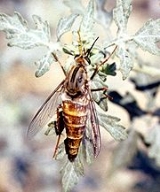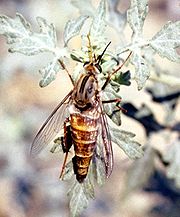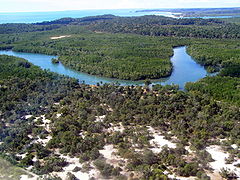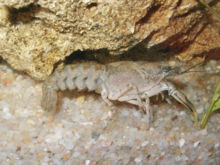
Endangered arthropod
Encyclopedia
An endangered arthropod is defined here as any of a number of species
within the phylum
Arthropoda, whose extinction
is likely in the foreseeable future (e.g. within one human generation). Estimating the number of arthropod endangered species is extremely difficult, primarily because a vast number of the species themselves are not yet named or described. Furthermore, according to Deyrup and Eisner: "The rate of destruction and degradation of natural habitats is currently so great that there are not nearly enough biologists to even catalog the arthropod
species that are suddenly on the edge of extinction." In any case, independent estimates indicate that there are millions of undocumented arthropods on Earth.
Arthropods as a group have been very successful organism
s on this planet, comprising over half of all the higher life form
s. However the expanding human population
has led to demise of many arthropod species through the mechanisms of deforestation
, conventional farming, slash-and-burn methods in the tropics, habitat fragmentation
via urban development, excessive use of pesticide
s and even the success of forest fire suppression.
The social/political practice whereby a species is given a formal designation as "Endangered" or "Protected" is a different matter, called "Conservation status
", and discussed elsewhere; see Endangered Species List for the United States
, and IUCN Red List
for international purposes. Only a tiny fraction of the planet's endangered arthropods are formally recognized as such, as no one has ever evaluated the conservation status of the vast majority of arthropod species.
 It is difficult to estimate the total number of endangered arthropod species, since many of the taxa themselves have not been recorded. For example, in North America
It is difficult to estimate the total number of endangered arthropod species, since many of the taxa themselves have not been recorded. For example, in North America
the estimated number of insect species exceeds 163,000, of which only about two thirds are taxonomically known. An even greater discovery awaiting, over 72 percent of North American arachnid
s are yet to be named and described.
The total number of living arthropod species is probably in the tens of millions. One conservative estimate puts the number of arthropod species in tropical forests alone at six to nine million species As a consequence of all of the above, most published estimates of the total number of endangered insects and arachnids are probably low by at least an order of magnitude. Conservatively at least eighty percent of all living animal species are arthropods.
s and other animals that prey upon arthropods. This includes enormous numbers of mammal
s, avafauna, fish
es, reptile
s and amphibian
s; in addition, arthropods constitute the bulk of faunal pollinator
s, so that the survival of crop
s as well as millions of natural flora
species depend on robust and biologically diverse
arthropod populations.
The survival of diverse arthropods is essential to propagation of higher animals on the food chain
, e.g. those species who prey upon the insectivores and other taxa that consume arthropods. Even if constant arthropod total biomass results after certain arthropod extinctions, the ecosystem stability is compromised by reduction in species numbers. Thus extinction of arthropods species threaten to make extinct hundreds of thousands, if not millions, of higher order birds, amphibians, reptiles and mammals.
 There are several pathways of endangerment for arthropods; however, most of them stem from the pressures of an expanding human population
There are several pathways of endangerment for arthropods; however, most of them stem from the pressures of an expanding human population
and resulting actions humans take to produce food, housing, transportation and recreation. Probably the greatest hazard to arthropod survival is agriculture
, due to the ever increasing demand of the human population to feed its expanding numbers. Agriculture typically results in a monoculture
that cannot support the biodiversity
nurtured by the predecessor natural environment. Normally arthropods represent the largest number of species that are displaced by such farming. In tropical regions the major threat is slash-and-burn agricultural techniques pursued by indigenous peoples in their sometimes only available method of subsistence.
Pesticide
use is also a major threat to arthropod species survival. Pesticides may have an intended effect of killing specified insects in a farming environment; however, considerable pesticide applications kill unintended species by the lack of specificity of most chemical formulations; moreover, much of the insect mortality arises from pesticide runoff
entering surface water
s or from transporting toxic chemicals to downgradient environments.
Habitat fragmentation
has special methods of endangerment beyond the amount of land consumed by the fragmenting agent. As an example, consider the construction of a highway
, whose width is an effective barrier to arthropod migration. Many arthropods never migrate more than about 200 feet from their place of birth, so a freeway or dual carriageway
effectively fragments many arthropod colonies such that they cannot interact. Studies have shown the greater vulnerability to extinction where habitats are fragmented.
 The following is a very small fraction of the potentially hundreds of thousands of endangered arthropods, limited to species which have been formally recognized as to their special conservation status:
The following is a very small fraction of the potentially hundreds of thousands of endangered arthropods, limited to species which have been formally recognized as to their special conservation status:
Species
In biology, a species is one of the basic units of biological classification and a taxonomic rank. A species is often defined as a group of organisms capable of interbreeding and producing fertile offspring. While in many cases this definition is adequate, more precise or differing measures are...
within the phylum
Phylum
In biology, a phylum The term was coined by Georges Cuvier from Greek φῦλον phylon, "race, stock," related to φυλή phyle, "tribe, clan." is a taxonomic rank below kingdom and above class. "Phylum" is equivalent to the botanical term division....
Arthropoda, whose extinction
Extinction
In biology and ecology, extinction is the end of an organism or of a group of organisms , normally a species. The moment of extinction is generally considered to be the death of the last individual of the species, although the capacity to breed and recover may have been lost before this point...
is likely in the foreseeable future (e.g. within one human generation). Estimating the number of arthropod endangered species is extremely difficult, primarily because a vast number of the species themselves are not yet named or described. Furthermore, according to Deyrup and Eisner: "The rate of destruction and degradation of natural habitats is currently so great that there are not nearly enough biologists to even catalog the arthropod
Arthropod
An arthropod is an invertebrate animal having an exoskeleton , a segmented body, and jointed appendages. Arthropods are members of the phylum Arthropoda , and include the insects, arachnids, crustaceans, and others...
species that are suddenly on the edge of extinction." In any case, independent estimates indicate that there are millions of undocumented arthropods on Earth.
Arthropods as a group have been very successful organism
Organism
In biology, an organism is any contiguous living system . In at least some form, all organisms are capable of response to stimuli, reproduction, growth and development, and maintenance of homoeostasis as a stable whole.An organism may either be unicellular or, as in the case of humans, comprise...
s on this planet, comprising over half of all the higher life form
Organism
In biology, an organism is any contiguous living system . In at least some form, all organisms are capable of response to stimuli, reproduction, growth and development, and maintenance of homoeostasis as a stable whole.An organism may either be unicellular or, as in the case of humans, comprise...
s. However the expanding human population
Overpopulation
Overpopulation is a condition where an organism's numbers exceed the carrying capacity of its habitat. The term often refers to the relationship between the human population and its environment, the Earth...
has led to demise of many arthropod species through the mechanisms of deforestation
Deforestation
Deforestation is the removal of a forest or stand of trees where the land is thereafter converted to a nonforest use. Examples of deforestation include conversion of forestland to farms, ranches, or urban use....
, conventional farming, slash-and-burn methods in the tropics, habitat fragmentation
Habitat fragmentation
Habitat fragmentation as the name implies, describes the emergence of discontinuities in an organism's preferred environment , causing population fragmentation...
via urban development, excessive use of pesticide
Pesticide
Pesticides are substances or mixture of substances intended for preventing, destroying, repelling or mitigating any pest.A pesticide may be a chemical unicycle, biological agent , antimicrobial, disinfectant or device used against any pest...
s and even the success of forest fire suppression.
The social/political practice whereby a species is given a formal designation as "Endangered" or "Protected" is a different matter, called "Conservation status
Conservation status
The conservation status of a group of organisms indicates whether the group is still extant and how likely the group is to become extinct in the near future...
", and discussed elsewhere; see Endangered Species List for the United States
United States
The United States of America is a federal constitutional republic comprising fifty states and a federal district...
, and IUCN Red List
IUCN Red List
The IUCN Red List of Threatened Species , founded in 1963, is the world's most comprehensive inventory of the global conservation status of biological species. The International Union for Conservation of Nature is the world's main authority on the conservation status of species...
for international purposes. Only a tiny fraction of the planet's endangered arthropods are formally recognized as such, as no one has ever evaluated the conservation status of the vast majority of arthropod species.
Difficulty of estimating numbers of species

North America
North America is a continent wholly within the Northern Hemisphere and almost wholly within the Western Hemisphere. It is also considered a northern subcontinent of the Americas...
the estimated number of insect species exceeds 163,000, of which only about two thirds are taxonomically known. An even greater discovery awaiting, over 72 percent of North American arachnid
Arachnid
Arachnids are a class of joint-legged invertebrate animals in the subphylum Chelicerata. All arachnids have eight legs, although in some species the front pair may convert to a sensory function. The term is derived from the Greek words , meaning "spider".Almost all extant arachnids are terrestrial...
s are yet to be named and described.
The total number of living arthropod species is probably in the tens of millions. One conservative estimate puts the number of arthropod species in tropical forests alone at six to nine million species As a consequence of all of the above, most published estimates of the total number of endangered insects and arachnids are probably low by at least an order of magnitude. Conservatively at least eighty percent of all living animal species are arthropods.
Ecological risks
Since arthropods constitute the majority of the faunal biomass on Earth, their role is vital to the survival of large numbers of insectivoreInsectivore
An insectivore is a type of carnivore with a diet that consists chiefly of insects and similar small creatures. An alternate term is entomophage, which also refers to the human practice of eating insects....
s and other animals that prey upon arthropods. This includes enormous numbers of mammal
Mammal
Mammals are members of a class of air-breathing vertebrate animals characterised by the possession of endothermy, hair, three middle ear bones, and mammary glands functional in mothers with young...
s, avafauna, fish
Fish
Fish are a paraphyletic group of organisms that consist of all gill-bearing aquatic vertebrate animals that lack limbs with digits. Included in this definition are the living hagfish, lampreys, and cartilaginous and bony fish, as well as various extinct related groups...
es, reptile
Reptile
Reptiles are members of a class of air-breathing, ectothermic vertebrates which are characterized by laying shelled eggs , and having skin covered in scales and/or scutes. They are tetrapods, either having four limbs or being descended from four-limbed ancestors...
s and amphibian
Amphibian
Amphibians , are a class of vertebrate animals including animals such as toads, frogs, caecilians, and salamanders. They are characterized as non-amniote ectothermic tetrapods...
s; in addition, arthropods constitute the bulk of faunal pollinator
Pollinator
A pollinator is the biotic agent that moves pollen from the male anthers of a flower to the female stigma of a flower to accomplish fertilization or syngamy of the female gamete in the ovule of the flower by the male gamete from the pollen grain...
s, so that the survival of crop
Crop
Crop may refer to:* Crop, a plant grown and harvested for agricultural use* Crop , part of the alimentary tract of some animals* Crop , a modified whip used in horseback riding or disciplining humans...
s as well as millions of natural flora
Flora
Flora is the plant life occurring in a particular region or time, generally the naturally occurring or indigenous—native plant life. The corresponding term for animals is fauna.-Etymology:...
species depend on robust and biologically diverse
Biodiversity
Biodiversity is the degree of variation of life forms within a given ecosystem, biome, or an entire planet. Biodiversity is a measure of the health of ecosystems. Biodiversity is in part a function of climate. In terrestrial habitats, tropical regions are typically rich whereas polar regions...
arthropod populations.
The survival of diverse arthropods is essential to propagation of higher animals on the food chain
Food chain
A food web depicts feeding connections in an ecological community. Ecologists can broadly lump all life forms into one of two categories called trophic levels: 1) the autotrophs, and 2) the heterotrophs...
, e.g. those species who prey upon the insectivores and other taxa that consume arthropods. Even if constant arthropod total biomass results after certain arthropod extinctions, the ecosystem stability is compromised by reduction in species numbers. Thus extinction of arthropods species threaten to make extinct hundreds of thousands, if not millions, of higher order birds, amphibians, reptiles and mammals.
Mechanisms of arthropod endangerment

Overpopulation
Overpopulation is a condition where an organism's numbers exceed the carrying capacity of its habitat. The term often refers to the relationship between the human population and its environment, the Earth...
and resulting actions humans take to produce food, housing, transportation and recreation. Probably the greatest hazard to arthropod survival is agriculture
Agriculture
Agriculture is the cultivation of animals, plants, fungi and other life forms for food, fiber, and other products used to sustain life. Agriculture was the key implement in the rise of sedentary human civilization, whereby farming of domesticated species created food surpluses that nurtured the...
, due to the ever increasing demand of the human population to feed its expanding numbers. Agriculture typically results in a monoculture
Monoculture
Monoculture is the agricultural practice of producing or growing one single crop over a wide area. It is also known as a way of farming practice of growing large stands of a single species. It is widely used in modern industrial agriculture and its implementation has allowed for large harvests from...
that cannot support the biodiversity
Biodiversity
Biodiversity is the degree of variation of life forms within a given ecosystem, biome, or an entire planet. Biodiversity is a measure of the health of ecosystems. Biodiversity is in part a function of climate. In terrestrial habitats, tropical regions are typically rich whereas polar regions...
nurtured by the predecessor natural environment. Normally arthropods represent the largest number of species that are displaced by such farming. In tropical regions the major threat is slash-and-burn agricultural techniques pursued by indigenous peoples in their sometimes only available method of subsistence.
Pesticide
Pesticide
Pesticides are substances or mixture of substances intended for preventing, destroying, repelling or mitigating any pest.A pesticide may be a chemical unicycle, biological agent , antimicrobial, disinfectant or device used against any pest...
use is also a major threat to arthropod species survival. Pesticides may have an intended effect of killing specified insects in a farming environment; however, considerable pesticide applications kill unintended species by the lack of specificity of most chemical formulations; moreover, much of the insect mortality arises from pesticide runoff
Surface runoff
Surface runoff is the water flow that occurs when soil is infiltrated to full capacity and excess water from rain, meltwater, or other sources flows over the land. This is a major component of the water cycle. Runoff that occurs on surfaces before reaching a channel is also called a nonpoint source...
entering surface water
Surface water
Surface water is water collecting on the ground or in a stream, river, lake, wetland, or ocean; it is related to water collecting as groundwater or atmospheric water....
s or from transporting toxic chemicals to downgradient environments.
Habitat fragmentation
Habitat fragmentation
Habitat fragmentation as the name implies, describes the emergence of discontinuities in an organism's preferred environment , causing population fragmentation...
has special methods of endangerment beyond the amount of land consumed by the fragmenting agent. As an example, consider the construction of a highway
Highway
A highway is any public road. In American English, the term is common and almost always designates major roads. In British English, the term designates any road open to the public. Any interconnected set of highways can be variously referred to as a "highway system", a "highway network", or a...
, whose width is an effective barrier to arthropod migration. Many arthropods never migrate more than about 200 feet from their place of birth, so a freeway or dual carriageway
Dual carriageway
A dual carriageway is a class of highway with two carriageways for traffic travelling in opposite directions separated by a central reservation...
effectively fragments many arthropod colonies such that they cannot interact. Studies have shown the greater vulnerability to extinction where habitats are fragmented.
Example endangered arthropods

- Alabama cave shrimpAlabama cave shrimpThe Alabama cave shrimp, Palaemonias alabamae, is a species of shrimp in the family Atyidae, found only in caves in the state of Alabama.-Conservation status:...
(Palaemonias alabamae) - California freshwater shrimp (Syncaris pacifica)
- Delhi Sands flower-loving flyDelhi Sands flower-loving flyThe Delhi Sands flower-loving fly is a mydid fly in the genus Rhaphiomidas, and the only fly presently on the Endangered Species List....
(Rhaphiomidas terminatus abdominalis), due to severely limited range of habitat and development - Kentucky cave shrimpKentucky cave shrimpThe Kentucky cave shrimp, Palaemonias ganteri, is an eyeless, troglobite shrimp. It lives in caves in Barren County, Edmonson County, Hart County and Warren County, Kentucky...
(Palaemonias ganteri) - Salt Creek tiger beetleSalt Creek tiger beetleThe Salt Creek tiger beetle, Cicindela nevadica lincolniana, is a critically endangered subspecies of tiger beetle endemic to the saline wetlands of northern Lancaster County, Nebraska, adjacent to and immediately to the north of the city of Lincoln. It is a predatory insect, using its mandibles...
(Cicindela nevadica lincolniana) - San Bruno elfin butterflySan Bruno elfin butterflyThe San Bruno elfin butterfly is a U.S. Federally listed endangered subspecies which inhabits rocky outcrops and cliffs in coastal scrub on the San Francisco peninsula, endemic to this habitat in California...
(Incisalia mossii bayensis), due to limited range of habitat and development encroachment - Smith's blue butterflySmith's blue butterflySmith's blue butterfly, Euphilotes enoptes smithi, is an organism in the family Lycaenidae, which is also known as the "gossamer wing" family...
(Euphilotes enoptes smithidue), to human overpopulationOverpopulationOverpopulation is a condition where an organism's numbers exceed the carrying capacity of its habitat. The term often refers to the relationship between the human population and its environment, the Earth...
of coastCoastA coastline or seashore is the area where land meets the sea or ocean. A precise line that can be called a coastline cannot be determined due to the dynamic nature of tides. The term "coastal zone" can be used instead, which is a spatial zone where interaction of the sea and land processes occurs...
al dunes areas and associated highwayHighwayA highway is any public road. In American English, the term is common and almost always designates major roads. In British English, the term designates any road open to the public. Any interconnected set of highways can be variously referred to as a "highway system", a "highway network", or a...
and land development - Spruce-fir moss spiderSpruce-fir moss spiderThe Spruce-fir moss spider, Microhexura montivaga, is an endangered species of spider found at high elevations in the southern Appalachian Mountains. First identified in 1923, they inhabit moss that grows on rocks underneath the forest canopy....
(Microhexura montivaga) - Tasmanian giant freshwater crayfishTasmanian giant freshwater crayfishThe Tasmanian giant freshwater crayfish is the largest freshwater invertebrate in the world. The species is only found in Tasmania , and is listed as a vulnerable species due to habitat loss and over fishing. It is also severely threatened by siltation and de-snagging of streams as decaying wood...
(Astacopsis gouldi) - Tooth cave spiderTooth cave spiderThe tooth cave spider is a 1/16 inch long arachnid. It is endemic to Texas and is considered an endangered species....
(Neoleptoneta myopica) - PoecilotheriaPoecilotheriaPoecilotheria is a genus of the family Theraphosidae containing various species of arboreal tarantula. This genus is known for vivid color patterns, fast movement, and potent venom compared to other tarantulas. The genus is native to Sri Lanka and India. The name Poecilotheria is derived from...
Parachute Tarantula (Poecilotheria spp) - White-clawed crayfishAustropotamobius pallipesAustropotamobius pallipes is an endangered European freshwater crayfish, and the only species of crayfish native to the British Isles. Its common names include white-clawed crayfish and Atlantic stream crayfish.-Distribution and ecology:...
(Austropotamobius pallipes)

